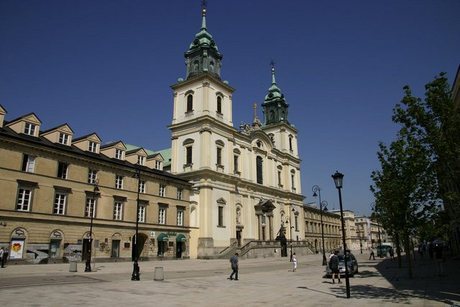Holy Cross Church
The Church of the Holy Cross (Polish: Kościół św. Krzyża, also Kościół świętokrzyski) is a Roman Catholic house of worship in downtown Warsaw, Poland. Located on Krakowskie Przedmieście opposite the main Warsaw University campus, it is one of the most notable Baroque churches in Poland's capital. The Holy Cross Church is currently administered by the Missionary Friars of Vincent de Paul.
As early as the 15th century, a small wooden chapel of the Holy Cross had been erected here. In 1526 the chapel was demolished, and a newer church was erected. Refurbished and extended by Paweł Zembrzuski in 1615, the church was too small to fill the needs of the growing city. Initially located well outside the city limits, by the 17th century it had become one of the main churches in the southern suburb (przedmieście) of the city that had in 1596 become Poland's capital. In 1653 Queen Marie Louise Gonzaga gave the church to the French order of Missionary Friars of Vincent de Paul. However, three years later Warsaw was captured by Swedish armies during the Deluge. Pillaged, the church was found to be damaged beyond repair. During the reign of Jan III Sobieski the church's remnants were demolished, and it was decided to erect a new shrine. In the 18th century this became the origin of the gorzkie żale tradition. Gorzkie żale is a Catholic devotion, containing many hymns. One part is held on each Sundays in the Lent period, and the entire ceremony is held on Good Friday. The main building was constructed between 1679 and 1696. Its main designer was Józef Szymon Bellotti, the royal architect at the Royal Court of Poland. It was financed by abbot Kazimierz Szczuka and the Primate of Poland Michał Stefan Radziejowski. The façade was relatively modest and reminded of Renaissance facades of the nearby churches. The two towers surrounding the façade were initially square-cut. Between 1725 and 1737 two late Baroque headpieces by Józef Fontana. The façade itself was refurbished by Fontana's son, Jakub (in 1756) and ornamented with sculptures by Jan Jerzy Plersch. From 1765 the church was one of the most attended by Polish King Stanisław August Poniatowski. It was also there that the King established the Order of St. Stanisław and bestowed it upon loyal servants annually on May 8. On May 3, 1792, the Polish Diet gathered there on the first anniversary of the May 3rd Constitution. During the Warsaw Uprising of 1794, the stairs leading to the main entrance were destroyed and had to be replaced with new ones designed by Chrystian Piotr Aigner. During the Partitions, the church gained much importance, especially after the 1861 demonstration held before it, which was brutally put down by Russian Cossack troops — sparking the January 1863 Uprising. On Christmas Day 1881, an outbreak of panic following a false alarm of fire in the crowded church caused the stampede deaths of twenty-nine persons. Jews were blamed for starting the panic, and the Warsaw pogrom of 1881 ensued. During the 1944 Warsaw Uprising, the church was severely damaged. On 6 September 1944, when the Germans detonated two large Goliath tracked mines in the church the facade was destroyed, together with many Baroque furnishings, the vaulting, the high altar, and side altars. Between 1945 and 1953, the church was rebuilt in a simplified architectural form by B. Zborowski. The interior was reconstructed without the Baroque polychromes and frescos. The main altar was reconstructed between 1960 and 1972.
No Chopinologist can leave Warsaw without first visiting the final resting place of his heart. Added to the church in 1882 his heart was sealed in an urn and then placed behind a tablet bearing his likeness specially carved by Leonardo Marconi.
Although this serves as the church's key draw there’s several other features of note to tempt the visitor inside this astonishing Baroque creation. The church's history originally dates from the 15th century when a small wooden chapel stood on the site. Destroyed during the Swedish Deluge of the 1650s construction on a church to replace it began in 1682, the cornerstone being ceremoniously laid by Prince Jakub, son of King Jan III Sobieski. Designed by the royal architect, Jakub Bellotti, it was completed in 1696 though through time would see numerous additions to its shape. The most notable of these would come in the following century when Józef Fontana added two Baroque crowns to the square-cut twin towers. His son Jakub would later extensively refurbish the façade with Jan Jerzy Plersch adding elaborate decorative touches to the interior.
Throughout history the church has played its role in Warsaw’s glories and calamities. It was here that the last Polish King forged the Order of the Knights of St. Stanislaus. Devastated during the Warsaw Uprising in 1944 the church was painstakingly rebuilt at the end of the war and is today a feast for the heart, eyes and soul. The organ (built in Salzburg in 1925) is the largest in Warsaw, and other points of note include an urn with the remains of Nobel Prize winning author Władysław Reymont, and tablets honouring various Polish icons including poet Juliusz Słowacki and WWII hero Władysław Sikorski.




